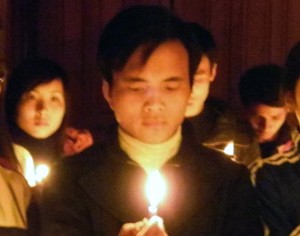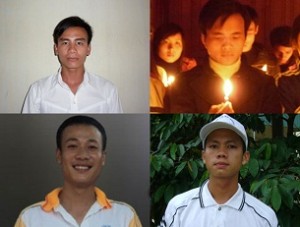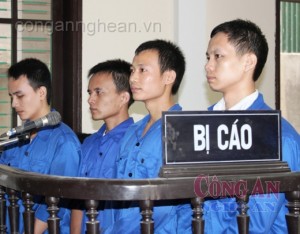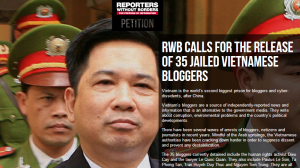By Bill Hayton, Tro Ly Ngheo,
Foreign Policy, May 12, 2020
The Communist Party’s tools of control made for effective virus-fighting weapons.
When the Hanoi-based economic consultant Raymond Mallon returned home after a trip abroad in late March, he was immediately texted by the local police asking after his health. Vietnam is a state that not only knows where you live but also knows when you go away—and your mobile phone number.
The degree of control matters because Vietnam has been widely praised for its success in tackling COVID-19. As of May 12, the country had, according to official statistics, suffered no deaths from the virus and had limited total infections to just 288, despite being next door to China and a popular holiday destination during the spring festival, when the coronavirus first hit the Chinese city of Wuhan. This has led many observers to suggest that the country’s pandemic control strategy could be a model for others to copy, especially for developing countries. But that is unlikely to succeed because few other countries have, or want to have, the structures of control that Vietnam possesses.
Todd Pollack, the country medical director of the Partnership for Health Advancement in Vietnam and a specialist in infectious diseases, ascribed Vietnam’s success to three factors: its relatively young population (just 12 percent of Vietnamese are over 60, compared with 22 percent in the United Kingdom); rigorous testing combined with early hospitalization for those found to be infected; and diligent contact tracing and isolation. It is the last of those three—the tracing and isolating of infected people—that enabled Vietnam to get its outbreak under control. As Matthew Moore, a Hanoi-based official from the U.S. Centers for Disease Control and Prevention, told Reuters: “The steps are easy to describe but difficult to implement, yet they’ve been very successful at implementing them over and over again.”
But the reason Vietnam’s disease control mechanisms have been so effective, and the reason why they are unlikely to be copied, is that they are the same mechanisms that facilitate and protect the country’s one-party rule. Vietnam has standing armies of neighborhood wardens and public security officers who keep constant watch over city blocks.Vietnam has standing armies of neighborhood wardens and public security officers who keep constant watch over city blocks. When required, they can be augmented by militia and self-defense forces with the ability to seal off entire districts. The structures that control epidemics are the same ones that control public expressions of dissent.
Several countries have deployed police as troops in the war against COVID-19, giving them extra powers to impose social order. In the Philippine town of Santa Cruz, for example, police detained five youths who violated the national lockdown in a dog cage. In March, France put 100,000 additional police officers on the streets to enforce its 15-day lockdown. But in Vietnam, police are not only watching you on the street. They track you to your front door, through your phone, and via your social media accounts.
In late March, a number of COVID-19 infections were discovered at the Bach Mai Hospital in southern Hanoi. In response, the chairman of the Hanoi People’s Committee (the city municipality), Maj. Gen. Nguyen Duc Chung, instructed thousands of police and local officials to visit every household in the neighborhoods for which they are responsible. One resident, Dang Bich Thao, told Foreign Policy that the same evening, a local police officer knocked on her door and those of other households in her building to ask if they or their families had visited the hospital.
Each inhabitant was checked against official residency lists and asked to explain their recent activities and travel history. “I felt like a criminal,” Ngo Minh Hoang told Foreign Policy, after a police officer knocked on his door in late March asking if he had traveled abroad during the last 14 days. “Although [the police] explained that the check was just for our own safety, I was still horrified,” Hoang added.
While the government has technological tools at its disposal, the foundation of its enormous security capacity is a vast human intelligence-gathering machine with the ability to trace and track individuals in person. Chung was the right man when it came to controlling the capital city. Until 2016, he was the director of Hanoi’s police department.
On May 2, the authorities closed off part of the Hanoi suburb of Gia Lam, quarantining 120 households (around 600 people) because one person was showing symptoms that could have been COVID-19. So-called district functional forces—uniformed police and militia—were pictured erecting barricades. Media photos also showed the men without uniforms who hold the real power in these situations. They work for the Ministry of Public Security: shadowy enforcers in polo shirts and slacks who can, depending on the situation, dish out orders to local officials or summon up the heavy mob with a phone call.
These are the same people who can barricade government critics inside their houses to prevent them meeting journalists, convene a neighborhood denunciation session to intimidate dissidents, or make sure someone’s kids get rough treatment at school if he or she makes too much noise about local corruption. The enforcers can be quite sure that their behavior is not going to be challenged by an independent judiciary because the Communist Party decides what the law is. Is it any wonder that people obey instructions to stay inside barricades when they live under a system that can make or break livelihoods by bureaucratic fiat?
These are the actual mechanisms that make the difference between the notional pandemic preparedness that the United States and United Kingdom were thought to enjoy and the real deal that Vietnam demonstrated. They were born as tools of Communist Party control and have now been repurposed in the service of health protection. The same systems, born from the same roots, made it possible for China to eventually control its outbreak, even after thousands of people died. The party’s supporters will applaud its efforts and the domestic intelligence panopticon that made it possible. Those who are more skeptical about surveillance states will be wary of trying to emulate its success.
Caroline Mills, who runs a small island resort near Hoi An, described on Twitter in late February how this surveillance worked in the case of one French visitor. According to Mills, the Frenchman had been flagged with a higher than normal temperature on arriving in Bangkok some 20 days earlier. After two days passing through Cambodia, he arrived in Vietnam. Unknown to him, the Vietnamese authorities monitored his entire journey through the country for 18 days. Within minutes of Mills logging his arrival at her hotel with the immigration service’s database, she received a call from the police. Officers were at the hotel to interview and test the Frenchman within 15 minutes.
This photograph taken on May 24, 2019 shows garment factory stitching apparel in a factory in Hanoi.
The military has also played a role in Vietnam’s battle against the virus. Sixty-eight military camps with a capacity of 40,000 people were set up to receive people ordered into quarantine. Nguyen Khanh (whose name has been changed to protect her identity), a 19-year-old who returned from studying in the U.K. and was quarantined in one of the camps, said she was woken up at 6 a.m. each day by a loudspeaker blaring a song declaring, “Our lives are a military march.” Similar messages were also being broadcast outside the camp. Each morning, the loudspeakers found on every street corner in Hanoi were also praising the contributions of the military and law enforcement agencies in fighting the virus.
At the same time, the authorities were stepping up their efforts against unauthorized information. According to local news reports, between Jan. 23, when Vietnam detected its first case of infection, and mid-March, police censored around 300,000 posts on news sites and blogs and 600,000 posts on social media about COVID-19. During those two months, police took action against 654 cases of so-called fake news and sanctioned 146 people. The overlap between the techniques useful for fighting misinformation and those for squashing political criticism is obvious. Vietnam sits at 175th on the Reporters Without Borders 2020 World Press Freedom Index.
While some other Asian states, notably South Korea, have used phone tracking, credit card records, and video surveillance to trace the travel history of infected people, only Vietnam and China are able to combine such technologies with the street muscle to maintain direct personal control over large numbers of people. Only Vietnam and China are able to do so permanently and without the need to submit to legal or parliamentary oversight.
While the international community has criticized Vietnam’s security apparatus in the past for violating its citizens’ rights, the country has received near-unanimous praise for its successful handling of the current pandemic. But the tools used are the same. For decades, the Communist Party has used surveillance, physical monitoring, and censorship to manage the population. The techniques have become more sophisticated, but Vietnam does not provide a model that many other countries are likely to either want or be able to implement.
Height Insoles: Hi, I do believe this is an excellent site. I stumbledupon …
http://fishinglovers.net: Appreciate you sharing, great post.Thanks Again. Keep writi…
Achilles Pain causes: Every weekend i used to pay a quick visit this site, as i w…






May 14, 2020
Vietnam’s Coronavirus Success Is Built on Repression
by Nhan Quyen • [Human Rights]
By Bill Hayton, Tro Ly Ngheo,
Foreign Policy, May 12, 2020
The Communist Party’s tools of control made for effective virus-fighting weapons.
When the Hanoi-based economic consultant Raymond Mallon returned home after a trip abroad in late March, he was immediately texted by the local police asking after his health. Vietnam is a state that not only knows where you live but also knows when you go away—and your mobile phone number.
The degree of control matters because Vietnam has been widely praised for its success in tackling COVID-19. As of May 12, the country had, according to official statistics, suffered no deaths from the virus and had limited total infections to just 288, despite being next door to China and a popular holiday destination during the spring festival, when the coronavirus first hit the Chinese city of Wuhan. This has led many observers to suggest that the country’s pandemic control strategy could be a model for others to copy, especially for developing countries. But that is unlikely to succeed because few other countries have, or want to have, the structures of control that Vietnam possesses.
Todd Pollack, the country medical director of the Partnership for Health Advancement in Vietnam and a specialist in infectious diseases, ascribed Vietnam’s success to three factors: its relatively young population (just 12 percent of Vietnamese are over 60, compared with 22 percent in the United Kingdom); rigorous testing combined with early hospitalization for those found to be infected; and diligent contact tracing and isolation. It is the last of those three—the tracing and isolating of infected people—that enabled Vietnam to get its outbreak under control. As Matthew Moore, a Hanoi-based official from the U.S. Centers for Disease Control and Prevention, told Reuters: “The steps are easy to describe but difficult to implement, yet they’ve been very successful at implementing them over and over again.”
But the reason Vietnam’s disease control mechanisms have been so effective, and the reason why they are unlikely to be copied, is that they are the same mechanisms that facilitate and protect the country’s one-party rule. Vietnam has standing armies of neighborhood wardens and public security officers who keep constant watch over city blocks.Vietnam has standing armies of neighborhood wardens and public security officers who keep constant watch over city blocks. When required, they can be augmented by militia and self-defense forces with the ability to seal off entire districts. The structures that control epidemics are the same ones that control public expressions of dissent.
Several countries have deployed police as troops in the war against COVID-19, giving them extra powers to impose social order. In the Philippine town of Santa Cruz, for example, police detained five youths who violated the national lockdown in a dog cage. In March, France put 100,000 additional police officers on the streets to enforce its 15-day lockdown. But in Vietnam, police are not only watching you on the street. They track you to your front door, through your phone, and via your social media accounts.
In late March, a number of COVID-19 infections were discovered at the Bach Mai Hospital in southern Hanoi. In response, the chairman of the Hanoi People’s Committee (the city municipality), Maj. Gen. Nguyen Duc Chung, instructed thousands of police and local officials to visit every household in the neighborhoods for which they are responsible. One resident, Dang Bich Thao, told Foreign Policy that the same evening, a local police officer knocked on her door and those of other households in her building to ask if they or their families had visited the hospital.
Each inhabitant was checked against official residency lists and asked to explain their recent activities and travel history. “I felt like a criminal,” Ngo Minh Hoang told Foreign Policy, after a police officer knocked on his door in late March asking if he had traveled abroad during the last 14 days. “Although [the police] explained that the check was just for our own safety, I was still horrified,” Hoang added.
While the government has technological tools at its disposal, the foundation of its enormous security capacity is a vast human intelligence-gathering machine with the ability to trace and track individuals in person. Chung was the right man when it came to controlling the capital city. Until 2016, he was the director of Hanoi’s police department.
On May 2, the authorities closed off part of the Hanoi suburb of Gia Lam, quarantining 120 households (around 600 people) because one person was showing symptoms that could have been COVID-19. So-called district functional forces—uniformed police and militia—were pictured erecting barricades. Media photos also showed the men without uniforms who hold the real power in these situations. They work for the Ministry of Public Security: shadowy enforcers in polo shirts and slacks who can, depending on the situation, dish out orders to local officials or summon up the heavy mob with a phone call.
These are the same people who can barricade government critics inside their houses to prevent them meeting journalists, convene a neighborhood denunciation session to intimidate dissidents, or make sure someone’s kids get rough treatment at school if he or she makes too much noise about local corruption. The enforcers can be quite sure that their behavior is not going to be challenged by an independent judiciary because the Communist Party decides what the law is. Is it any wonder that people obey instructions to stay inside barricades when they live under a system that can make or break livelihoods by bureaucratic fiat?
These are the actual mechanisms that make the difference between the notional pandemic preparedness that the United States and United Kingdom were thought to enjoy and the real deal that Vietnam demonstrated. They were born as tools of Communist Party control and have now been repurposed in the service of health protection. The same systems, born from the same roots, made it possible for China to eventually control its outbreak, even after thousands of people died. The party’s supporters will applaud its efforts and the domestic intelligence panopticon that made it possible. Those who are more skeptical about surveillance states will be wary of trying to emulate its success.
Caroline Mills, who runs a small island resort near Hoi An, described on Twitter in late February how this surveillance worked in the case of one French visitor. According to Mills, the Frenchman had been flagged with a higher than normal temperature on arriving in Bangkok some 20 days earlier. After two days passing through Cambodia, he arrived in Vietnam. Unknown to him, the Vietnamese authorities monitored his entire journey through the country for 18 days. Within minutes of Mills logging his arrival at her hotel with the immigration service’s database, she received a call from the police. Officers were at the hotel to interview and test the Frenchman within 15 minutes.
This photograph taken on May 24, 2019 shows garment factory stitching apparel in a factory in Hanoi.
The military has also played a role in Vietnam’s battle against the virus. Sixty-eight military camps with a capacity of 40,000 people were set up to receive people ordered into quarantine. Nguyen Khanh (whose name has been changed to protect her identity), a 19-year-old who returned from studying in the U.K. and was quarantined in one of the camps, said she was woken up at 6 a.m. each day by a loudspeaker blaring a song declaring, “Our lives are a military march.” Similar messages were also being broadcast outside the camp. Each morning, the loudspeakers found on every street corner in Hanoi were also praising the contributions of the military and law enforcement agencies in fighting the virus.
At the same time, the authorities were stepping up their efforts against unauthorized information. According to local news reports, between Jan. 23, when Vietnam detected its first case of infection, and mid-March, police censored around 300,000 posts on news sites and blogs and 600,000 posts on social media about COVID-19. During those two months, police took action against 654 cases of so-called fake news and sanctioned 146 people. The overlap between the techniques useful for fighting misinformation and those for squashing political criticism is obvious. Vietnam sits at 175th on the Reporters Without Borders 2020 World Press Freedom Index.
While some other Asian states, notably South Korea, have used phone tracking, credit card records, and video surveillance to trace the travel history of infected people, only Vietnam and China are able to combine such technologies with the street muscle to maintain direct personal control over large numbers of people. Only Vietnam and China are able to do so permanently and without the need to submit to legal or parliamentary oversight.
While the international community has criticized Vietnam’s security apparatus in the past for violating its citizens’ rights, the country has received near-unanimous praise for its successful handling of the current pandemic. But the tools used are the same. For decades, the Communist Party has used surveillance, physical monitoring, and censorship to manage the population. The techniques have become more sophisticated, but Vietnam does not provide a model that many other countries are likely to either want or be able to implement.